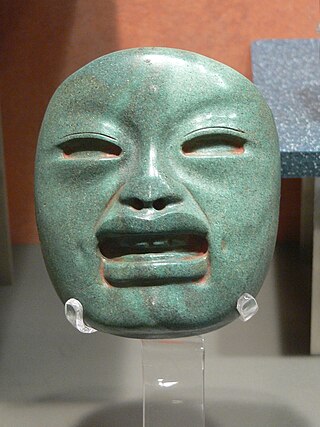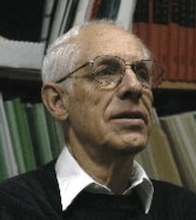John Edward Clark (born 1952) [1] is an American archaeologist and academic researcher of pre-Columbian Mesoamerican cultures. As of 2008 [update] he holds a position as professor of anthropology at Brigham Young University (BYU), and is also the director of the New World Archaeology Foundation.
Clark pursued undergraduate and postgraduate studies in archaeology and anthropology at BYU, completing a B.A. in 1976 and obtaining his Master's degree in 1979. His doctorate studies were completed at University of Michigan, from where he was awarded his PhD in 1994.
Clark has written and lectured extensively theoretical topics and the archaeology of Mesoamerica, where he has particularly focused on the Olmecs and their culture. He has also written papers on the Book of Mormon and archaeology.
Among books Clark was involved in writing is Olmec Art and Archaeology in Mesoamerica. [2]
Clark has lived in and performed extensive archaeological research while living and working in Mexico for several decades.
In 2005 Clark was one of the speakers at the Worlds of Joseph Smith symposium at the Library of Congress. [3]
Clark is a member of the Church of Jesus Christ of Latter-day Saints who accepts the historicity of the Book of Mormon.

Since the publication of the Book of Mormon in 1830, Mormon and non-Mormon archaeologists have attempted to find archaeological evidence to support it. Although historians, archaeologists, and those outside the religion who have examined the topic consider the book to be an anachronistic invention of Joseph Smith, many members of the Church of Jesus Christ of Latter-day Saints and other denominations of the Latter Day Saint movement believe that it describes ancient historical events in the Americas.
Dennis Michael Quinn was an American historian who focused on the history of The Church of Jesus Christ of Latter-day Saints. He was a professor at Brigham Young University (BYU) from 1976 until he resigned in 1988. At the time, his work concerned church involvement with plural marriage after the 1890 Manifesto, when new polygamous marriages were officially prohibited. He was excommunicated from the church as one of the September Six and afterwards was openly gay. Quinn nevertheless identified as a Latter-day Saint and continued to believe in many LDS teachings, though he did not actively practice the faith.

Ivan Gladstone Van Sertima was a Guyanese-born British associate professor of Africana Studies at Rutgers University in the United States.

Michael Douglas Coe was an American archaeologist, anthropologist, epigrapher, and author. He is known for his research on pre-Columbian Mesoamerica, particularly the Maya, and was among the foremost Mayanists of the late twentieth century. He specialised in comparative studies of ancient tropical forest civilizations, such as those of Central America and Southeast Asia. He held the chair of Charles J. MacCurdy Professor of Anthropology, Emeritus, Yale University, and was curator emeritus of the Anthropology collection in the Peabody Museum of Natural History, where he had been curator from 1968 to 1994.

Olmec alternative origin speculations are non-mainstream pseudohistorical theories that have been suggested for the formation of Olmec civilization which contradict generally accepted scholarly consensus. These origin theories typically involve contact with Old World societies. Although these speculations have become somewhat well-known within popular culture, particularly the idea of an African connection to the Olmec, they are not regarded as credible by mainstream researchers of Mesoamerica and are considered fringe theories.

Matthew Williams Stirling was an American ethnologist, archaeologist and later an administrator at several scientific institutions in the field. He is best known for his discoveries relating to the Olmec civilization. Much of his work was done with his "wife and constant collaborator" of 42 years Marion Stirling.

Chiapa de Corzo is an archaeological site of pre-Columbian Mesoamerica located near the small town of Chiapa de Corzo, Chiapas.
Stephen Douglas Houston is an American anthropologist, archaeologist, epigrapher, and Mayanist scholar, who is particularly renowned for his research into the pre-Columbian Maya civilization of Mesoamerica. He is the author of a number of papers and books concerning topics such as the Maya script, the history, kingships and dynastic politics of the pre-Columbian Maya, and archaeological reports on several Maya archaeological sites, particularly Dos Pilas and El Zotz. In 2021, National Geographic noted that he participated in the correct cultural association assigned to a half-size replica discovered at the Tikal site of the six-story pyramid of the mighty Teotihuacan culture, which replicated its Citadel that includes the original Feathered Serpent Pyramid.

Karl Andreas Taube is an American Mesoamericanist, Mayanist, iconographer and ethnohistorian, known for his publications and research into the pre-Columbian cultures of Mesoamerica and the American Southwest. He is Distinguished Professor of Anthropology at the College of Humanities, Arts, and Social Sciences, University of California, Riverside. In 2008 he was named the College of Humanities, Arts, and Social Sciences distinguished lecturer.

Many members of the Latter Day Saint movement believe that the Book of Mormon is historically accurate. Most, but not all, Latter Day Saints hold the book's connection to ancient American history as an article of their faith. This view finds no confirmation outside of the movement in the broader scientific community. Mainstream archaeological, historical, and scientific communities do not consider the Book of Mormon an ancient record of actual historical events.
Terry Briggs Ball was the dean of Religious Education at Brigham Young University (BYU) from 2006 until 2013.
David C. Grove was an American anthropologist, archaeologist and academic, known for his contributions and research into the Preclassic period cultures of Mesoamerica, in particular those of the Mexican altiplano and Gulf Coast regions. A lecturer and professor at University of Illinois at Urbana-Champaign (UIUC) for some thirty years, Grove retained a position as Professor Emeritus of Anthropology at UIUC and was also designated a Courtesy Professor of Anthropology at the University of Florida.
Brigham Young University Press was the university press of Brigham Young University (BYU).

There are a number of words and phrases in the Book of Mormon that are anachronistic—their existence in the text of the Book of Mormon is at odds with known linguistic patterns or archaeological findings.

John Leon Sorenson was an American anthropologist, scholar and author. He was a professor of anthropology at Brigham Young University, and the author of An Ancient American Setting for the Book of Mormon, as well as many other books and articles on the Book of Mormon and archaeology.
Richard A. Diehl is an American archaeologist, anthropologist, academic, and scholar of pre-Columbian Mesoamerican cultures. He has made extensive contributions to the study of the Olmecs' civilization, which flourished in the Gulf Coast of Mexico region during the pre-classic period in Mesoamerica.
The New World Archaeological Foundation (NWAF) is an archaeological organization run by Brigham Young University. When founded it was the largest archeological project funded by a religious institution. It was founded by Thomas Stuart Ferguson who sought to show how the history of Mesoamerican cultures proved the historicity of the Book of Mormon. Ferguson however found evidence to the contrary and from 1961 he kept a low profile as a secretary to the foundation which then became associated with the Brigham Young University and renamed as the BYU-NWAF.
Floyd LaMond Tullis was a professor of political science and Associate Academic Vice President at Brigham Young University (BYU) from 1969 to 1998. He is a specialist in Latin American Studies and has written multiple works on the Church of Jesus Christ of Latter-day Saints in Latin America, especially Mexico.
Susan D. Gillespie is an American academic anthropologist and archaeologist, noted for her contributions to archaeological and ethnohistorical research on pre-Columbian Mesoamerican cultures, in particular the Aztec, Maya and Olmec. As of 2009 Gillespie holds a position as professor in the Department of Anthropology at University of Florida, Gainesville, USA, having also been associate chair of the department from 2003 until 2009.
David Cheetham is a Canadian archaeologist. He works primarily in Central America and specializes in the identification of Preclassic/Formative era structures and pottery.